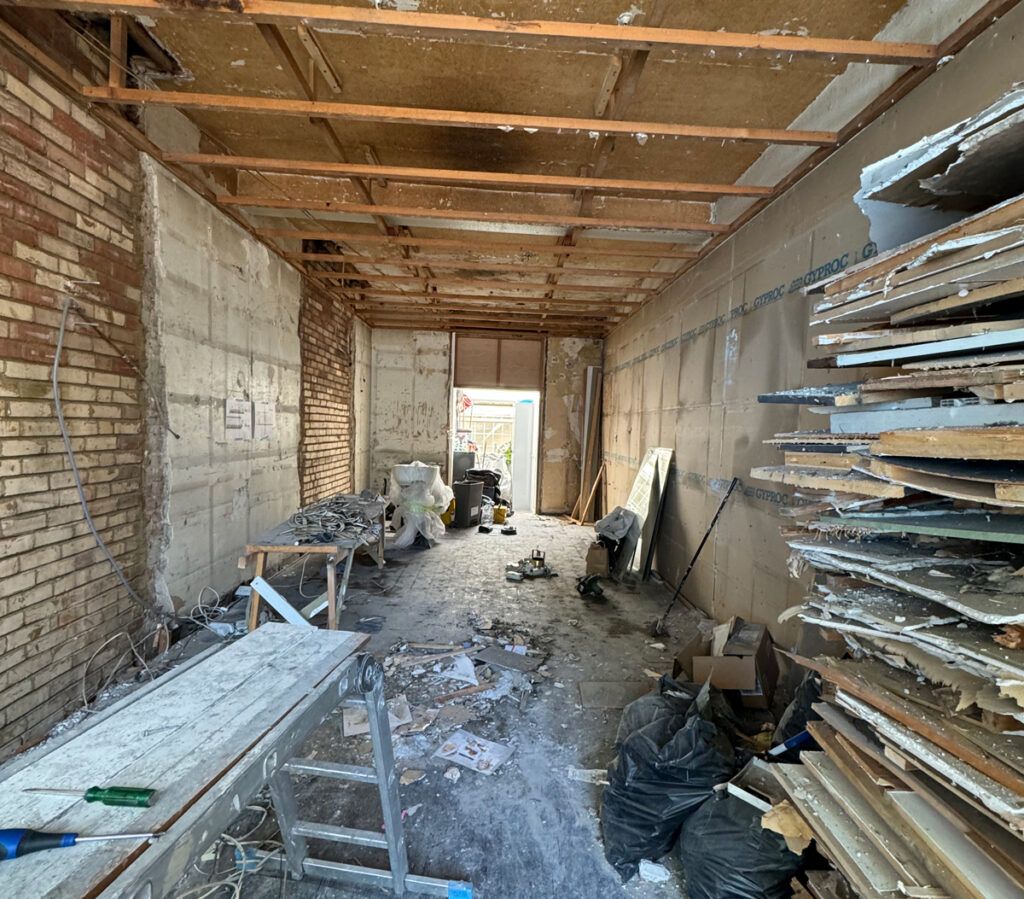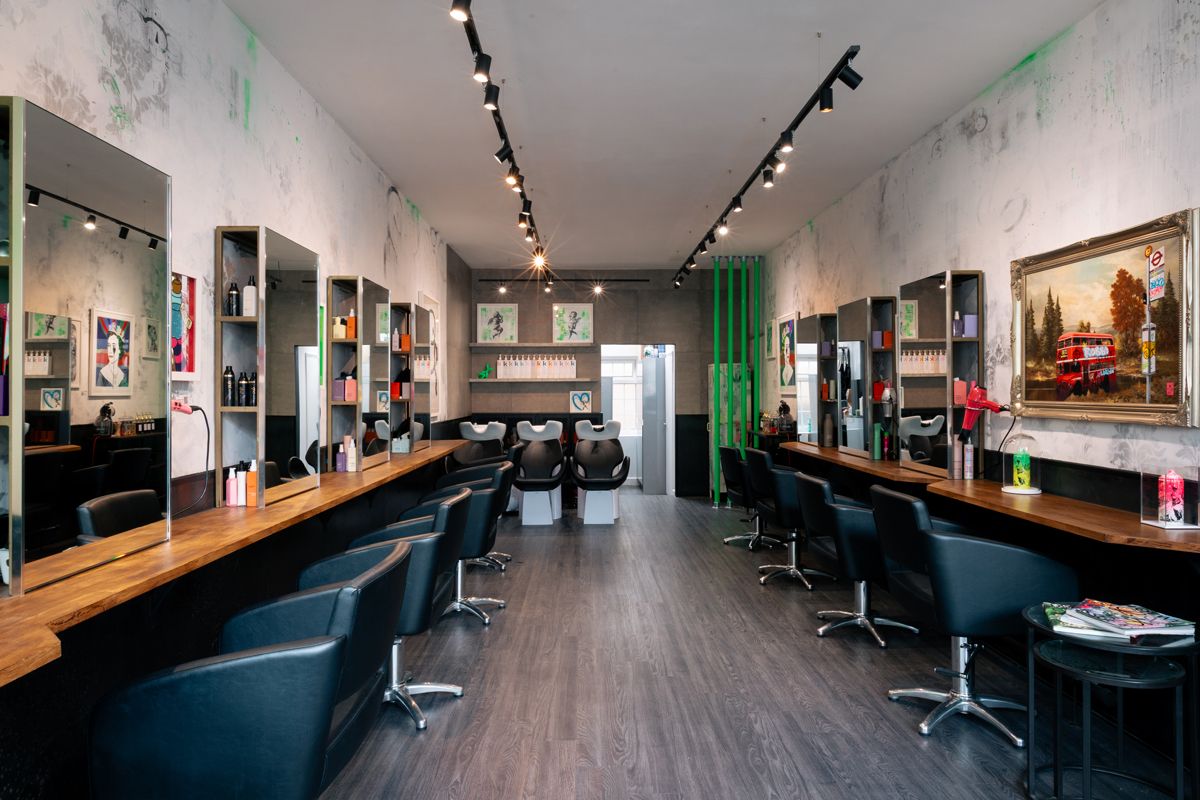Interior design in a hair salon goes far beyond aesthetics. Behind a vibrant and characterful space like the new Sarah Hepburn Stylists salon in Islington, London, lies a complex choreography of technical decisions, relationships with contractors and subcontractors, budget adjustments and construction challenges—often tackled within tight timeframes.
The design involved the full renovation of an old salon into a new space managed by stylist Sarah Castañares. The comprehensive transformation required more than a strong design concept—it demanded a clear strategy to execute the works with precision, efficiency, and long-lasting results.
To reduce the salon’s closure time and enable a swift reopening, the project was strategically divided into two phases. The first phase focused on the back-of-house area: a functional kitchen for the team, a colour workshop, and preparation zones where products are handled. It started from the back to keep the public-facing areas closed for as little time as possible.
Once that phase was completed, the salon shut fully; the previous interior was demolished, a continuous floor was installed and walls were clad up to mid-height. The industrial aesthetic then took shape, featuring grey furnishings, metal lockers and neutral white finishes.
Working with reliable contractors in London is not always straightforward. It is common for each client to suggest their own trusted team—but when they don’t, Leonor’s studio turns to its established network of collaborators. There always are several trusted contractors available, and so estimating begins as soon as the design is defined, with materials, elevations and 3D models in place.
Selection is based not only on cost, but on the ability to meet deadlines, adapt to unforeseen circumstances, and maintain clear communication throughout the process. “We expect contractors to meet deadlines and respond to the unexpected. That’s why profiles were chosen that offer flexibility and help adjust the design if surprises arise when opening up ceilings or floors.
The design team—which typically works with two or three general contractors who take care of almost everything—set forth with the demolition, masonry, lighting, installation and finishing. These professionals act as site coordinators, but highly specific tasks—such as the fabrication of furniture, mirrors and metal mesh panels—are subcontracted to specialists.
Similarly, custom furniture, mural graffiti, and façade vinyls were handled by different specialists. Suppliers were sourced in parallel to the building works to maintain control over finishes, lead times, and the quality of what was installed.
Several surprises emerged during demolition: hidden mirrors behind walls, remnants of an older salon and even a second ceiling that wasn’t shown in the original plans. The false ceiling was removed, gaining half a metre in height and completely transforming the perception of the space.
The works also involved lifting the floor to install new plumbing and an updated heating system with radiators. The entire space was clad in plasterboard, including a suspended ceiling that enabled a cleaner installation of lighting and electrical systems.
The team worked layer by layer: first placing the structural elements and partitions, then painting the surfaces. During this stage, the electrician continued routing cables between layers. Finally, white paint was applied to complete the finish.
One of the project’s most significant moments was the arrival of British artist David Schmidt (DS Art), who created a hand-painted mural installation, built up layer by layer. Support boards were first installed, then sprayed with graffiti, and finally finished with successive textures to achieve the desired effect. Schmidt, who came in and worked on site, was part of the fluid collaboration between art and architecture.
Once the technical installations were complete, the main contractor laid the final flooring, tiled the walls, and completed the lighting. At this point, specialist joiners came in to install shelving, mirrors, wooden ledges, and signage.
The façade was refreshed with a coat of white paint and a new sign, accompanied by neon green vinyl graphics—an element that has become the salon’s visual signature. These adhesive and easily replaceable vinyls allow for aesthetic intervention without altering the structure.
 The project also follows a modern logic of flexible use. The 45-square-metre salon includes eight hairdressing stations, four of which are available for freelance professionals to rent by the day. The design needed to accommodate this rotation, with dedicated lockers and modular furniture.
The project also follows a modern logic of flexible use. The 45-square-metre salon includes eight hairdressing stations, four of which are available for freelance professionals to rent by the day. The design needed to accommodate this rotation, with dedicated lockers and modular furniture.
Practical features were introduced, including countertops for clients to use laptops while waiting, an automated colour mixing system and a waiting area integrated into the entrance. The aim was not only visual appeal but also efficiency, intuitive use and easy maintenance for daily operations.
The success of the Sarah Hepburn Stylists project lies not only in its industrial aesthetic and expressive use of colour, but also in how it was delivered—through well-planned phases, reliable contractors, specialist subcontractors and flexible project supervision.
Ultimately, the project reflects a balance of design vision, adaptability during construction, and the contributions of all collaborators, resulting in a space that is both functional and full of character.
Sara Leonor, an Interior Design graduate of IADE with a master’s in Pure Design, spent 12 years at London’s B3 Designers before founding her own studio in 2018. Based in Islington, she focuses on interiors and bespoke products, including furniture, lighting and signature chairs, blending creativity with client collaboration. For more information, visit www.saraleonorstudio.co.uk.
View the original article and our Inspiration here


Leave a Reply